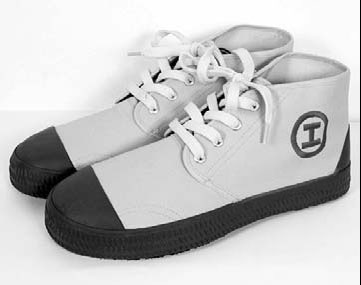Life and Leisure
Fashionistas unite over 'liberation shoes'
By Xu Lin (China Daily)
Updated: 2010-09-30 08:02
 |
Large Medium Small |
|
Liberation shoes, the once outdated and cheap shoes, are becoming a fashion must-have. Provided to China Daily |
"Liberation shoes" are making a comeback in their homeland after becoming a fashion must-have abroad.
The green canvas shoes with soft rubber soles and toecaps, formerly worn by the People's Liberation Army (PLA) and ordinary people in China since the 1950s, have been updated for the 21st century.
Matched with a sailor's striped shirt and navy blue pants they create a stylish look that is full of nostalgia.
The shoes, which used to be widely available in China for less than 10 yuan ($1.50), now sell for as much as $73 in the United States, after being redesigned and improved.
The upgraded version of the liberation shoe is called Ospop (One Small Point of Pride) and they are also popular in Europe and Japan. About 200,000 pairs a year have been exported.
Now they are becoming popular once more in China.
The principal manufacturer, Tianlang Shoe Corp Ltd, in Wenxian county, Henan province, has recently announced plans to open several chain stores in first-tier cities such as Beijing and Shanghai.
The move aims to capitalize on the craze for buying liberation shoes online through domestic online retailers like Taobao.com, where a pair can be snapped up for 164 yuan ($24).
"The shoes are popular because their insoles are very comfortable," Zhang Zhengrong, an online seller, says.
When Zhang first started selling the shoes online there were few sellers, or buyers. But last month he sold more than 400 pairs.
"The gray color series is already out of stock," Zhang says. "I am receiving more orders as many domestic newspapers and TV stations are reporting how popular the shoes are in foreign countries."
Liberation shoes made their debut in 1950, when the first PLA military uniform was introduced.
They quickly became popular because of their flexibility, durability, softness, lightness and cheap price.
Their popularity, particularly among farmers, miners and migrant workers, lasted until the 1990s, when they were viewed by youth as outdated and cheap.
The PLA wore them during training and in combat for 54 years, until 2004. Freshmen at university still wear them during their military training.
Even Premier Wen Jiabao wore a pair when he visited victims of the Huaihe River flooding, in 2007.
Cui Hua, general manager of Tianlang Shoe Corp, says US citizen Ben Walters approached him in 2005, to produce the Ospop brand.
Walters had noticed construction workers wearing liberation shoes in Shanghai and thought they were comfortable and chic. He bought a pair and contacted Cui through the number printed on the packaging.
"I thought he was a fraud at first," Cui says.
But Walters was serious and is now the exclusive distributor of Ospop to 12 countries and regions.
After two years of research and improvements, Ospop landed in the US in 2007 and quickly became a hit. The shoes were then exported to France, Germany, Italy and Japan.
Ospop offers a wider range of choice for consumers, compared with the original liberation shoes, in terms of color, style and size. There is even a line for children. The shoes are better ventilated and are waterproof, using eco-friendly materials and higher quality rubber.
The circled Chinese character, gong, meaning laborer, is the Ospop logo.
"Unlike the old liberation shoes, Ospop smells good, without any rubbery odor," says Han Jie, 20, who bought a pair of Ospop online. "But I won't buy the green ones, as they look much the same as the old liberation shoes."
Ospop is the latest brand of shoes to catch the wave of nostalgia for Chinese shoes after Huili, known as Warrior overseas, and Feiyue sneakers in 2008.
Previously, fashion giants like Louis Vuitton and Calvin Klein have adopted Chinese working class chic.
In 2007, Louis Vuitton introduced a striped plastic bag that was similar to the cheap plastic bags used by migrant workers, but cost 4,000 times more. Calvin Klein's range of black cloth shoes were similar to the handmade shoes that used to be made by many Chinese grandmothers.
"Innovation counts. A few improvements can make a big difference," Tianlang Shoe Corp's Cui says.
China Daily
(China Daily 09/30/2010 page20)
